
PDF Publication Title:
Text from PDF Page: 005
Lithium Recovery from Brines Including Seawater, Salt Lake Brine, Underground Water... DOI: http://dx.doi.org/10.5772/intechopen.90371 have previously been reported, including metal oxides, clay minerals, silicotitanates and zirconium phosphate. The main attention of the researchers was focused on the adsorbents of titanium-lithium ion sieves [39–43] manganese-lithium ion sieves [44–50] and aluminum salts [51, 52]. Adsorbents of aluminum salts [52] showed stable and high selectivity for Li+ with lithium absorption of only 2–3 mg g−1. By Chitrakar et al. [53] nanoscale H2TiO3 was synthesized by solid-phase reaction and its adsorption capacity with lithium reached 32 mg g−1 [41]. Tang et al. and Zhang et al. were synthesized H2TiO3 using different raw materials [41, 42]. Wang et al. synthesized lithium-enriched β-Li2TiO3 with a maximum lithium absorption of 76.7 mg g−1 in LiOH alkali solution [43]. Despite the fact the maximum absorption of Li+ adsorbent H2TiO3 from the lithium-enriched solution has reached 76.7 mg g−1, the high cost of synthesis and loss of dissolution of the titanium ion is still an obstacle. Chitrakar et al. by hydrothermal reaction synthesized Li1.6Mn1.6O4 and with 52 mg g−1 Li+ adsorption capacity [48]. By Xiao et al. synthesized spinel-struc- tured hydrogen oxides of manganese, the saturated adsorption capacity of which was up to 42 mg g−1 [54]. 1-D MnO2 was synthesized with a maximum adsorption capacity reaching 46.34 mg g−1 in LiOH solution (C0 = 35 mg L−1) [50]. In this case, the dismutation reaction during etching can lead to distortion of the lattice and dissolution of manganese, which will violate its cyclicality. In addition to lithium and magnesium, the treated salt lake brines may contain significant concentrations of potassium, sodium and boron. Zhou et al. compared the competitive sequences for several cations using TBP/FeCl3 in MIBK as the extractant [55–57]. However, quantitative correlations for competing for ion extrac- tions, which are crucial in industrial design, were not reported. The review is devoted to the extraction of lithium from brines, marine and geo- thermal waters, the collection of different methods of lithium extraction from water resources, which makes it possible to compare different methods that determine the optimal path for further research. Moreover, scientists around the world are chal- lenged to find a way to extract lithium from water resources that are environmen- tally friendly, highly selective, economical, time-efficient and easy to process. 2. Lithium extraction Lithium is comparatively abundant on the earth’s crust, being the affluent 25th more element [58]. More than 150 minerals contain lithium, in solid sediments, in geothermal waters, in many continental brines and in seawater. The concentration of lithium in seawater is very low, with an average of 0.17 ppm [3, 59]. The change in concentration from 1 to 100 ppm shows geothermal waters around the world [2, 4]. Although lithium deposits in all of the above forms are widespread throughout the world, only a very few are large enough and/or concentrated to potentially allow their exploitation. Several high-grade lithium minerals and brines are the only ones cur- rently manufacturing at lithium extraction [2–4]. Interest in the recycling of lithium batteries has grown in recent years. However, recycling is still not economically attractive if compared with the mining of the raw materials [60]. Facilities for recycling are now available in the USA, Canada, Belgium, Germany and Japan. However, lithium availability from recycling is insignificant as compared with mined raw materials [61]. Figures for lithium resources and reserves differ considerably accordingly to the source, although there is unanimously agreement that lithium resources in brine are much larger than those in hard rock [2–4, 6]. The latest data from the U.S. Geological Survey show that total lithium resources (brine + hard rock) are 54.1 million tons. It was reported that the minimum and maximum reserves of lithium 3PDF Image | Lithium Recovery from Seawater Salt Lake Brine

PDF Search Title:
Lithium Recovery from Seawater Salt Lake BrineOriginal File Name Searched:
IntechOpenSamadiyBookchapter.pdfDIY PDF Search: Google It | Yahoo | Bing
Product and Development Focus for Infinity Turbine
ORC Waste Heat Turbine and ORC System Build Plans: All turbine plans are $10,000 each. This allows you to build a system and then consider licensing for production after you have completed and tested a unit.Redox Flow Battery Technology: With the advent of the new USA tax credits for producing and selling batteries ($35/kW) we are focussing on a simple flow battery using shipping containers as the modular electrolyte storage units with tax credits up to $140,000 per system. Our main focus is on the salt battery. This battery can be used for both thermal and electrical storage applications. We call it the Cogeneration Battery or Cogen Battery. One project is converting salt (brine) based water conditioners to simultaneously produce power. In addition, there are many opportunities to extract Lithium from brine (salt lakes, groundwater, and producer water).Salt water or brine are huge sources for lithium. Most of the worlds lithium is acquired from a brine source. It's even in seawater in a low concentration. Brine is also a byproduct of huge powerplants, which can now use that as an electrolyte and a huge flow battery (which allows storage at the source).We welcome any business and equipment inquiries, as well as licensing our turbines for manufacturing.| CONTACT TEL: 608-238-6001 Email: greg@infinityturbine.com | RSS | AMP |